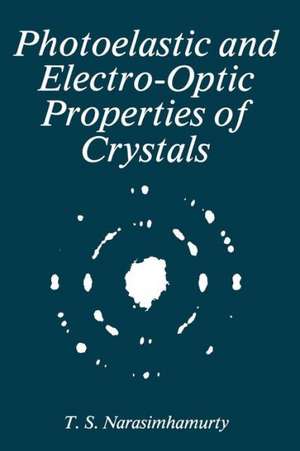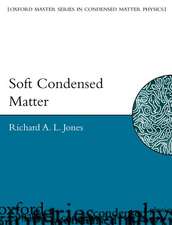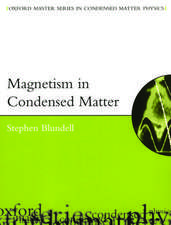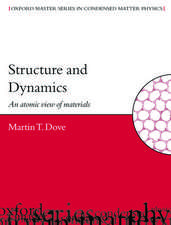Photoelastic and Electro-Optic Properties of Crystals
Autor T. S. Narasimhamurtyen Limba Engleză Paperback – 14 iun 2012
Preț: 651.51 lei
Preț vechi: 766.49 lei
-15% Nou
Puncte Express: 977
Preț estimativ în valută:
124.67€ • 129.32$ • 103.96£
124.67€ • 129.32$ • 103.96£
Carte tipărită la comandă
Livrare economică 27 martie-10 aprilie
Preluare comenzi: 021 569.72.76
Specificații
ISBN-13: 9781475700275
ISBN-10: 147570027X
Pagini: 548
Ilustrații: 544 p. 36 illus.
Dimensiuni: 152 x 229 x 29 mm
Greutate: 0.73 kg
Ediția:Softcover reprint of the original 1st ed. 1981
Editura: Springer Us
Colecția Springer
Locul publicării:New York, NY, United States
ISBN-10: 147570027X
Pagini: 548
Ilustrații: 544 p. 36 illus.
Dimensiuni: 152 x 229 x 29 mm
Greutate: 0.73 kg
Ediția:Softcover reprint of the original 1st ed. 1981
Editura: Springer Us
Colecția Springer
Locul publicării:New York, NY, United States
Public țintă
ResearchCuprins
1. Photoelasticity of Crystals. Introduction.- 1.1. Discovery of the Phenomenon of Photoelasticity.- 1.2. Mathematical Formulation and Neumann’s Constants. Pockels’ Contribution.- 1.3. A Brief Historical Survey.- 2. Mathematical Tools, Tensor Properties of Crystals, and Geometrical Crystallography.- 2.1. Linear Transformations.- 2.2. Matrix Algebra.- 2.3. Vectors and Their Transformation Laws.- 2.4. Tensor Nature of Physical Properties of Crystals and the Laws of Transformation of Cartesian Tensors.- 2.5. Crystal Symmetry and Geometrical Crystallography. The 32 Point Groups.- 2.6. Symmetry Operations and Their Transformation Matrices.- 2.7. Symmetry Elements of the 32 Point Groups.- 2.8. Neumann’s Principle and Effect of Crystal Symmetry on Physical Properties.- 3. Pockels’ Phenomenological Theory of Photoelasticity of Crystals.- 3.1. Introduction.- 3.2. Phenomenological Theory, Stress-Optical and Strain-Optical Constants in Four- and Two-Suffix Notations; qij and pij Matrices for the 32 Crystallographic Point Groups.- 3.3. Derivation of the Nonvanishing and Independent Photoelastic Constants for the Various Crystal Classes by Different Methods.- 4. Elasticity of Crystals.- 4.1. Introduction.- 4.2. Stress and Strain as Tensors.- 4.3. Hooke’s Law.- 4.4. Experimental Methods of Determining cij and sij; Christoffel’s Equation and Its Use in Determining cij of Crystals.- 4.5. Ultrasonics.- 4.6. Brillouin Effect and Crystal Elasticity.- 5. Experimental Methods of Determining the Photoelastic Constants.- 5.1. Optical Behavior of a Solid under a Mechanical Stress, and Neumann’s Constants.- 5.2. Derivation of Expressions for the Stress Birefringence in Terms of qij for Cubic and Noncubic Crystals.- 5.3. Experimental Determination of qij and pij by OpticalMethods.- 5.4. Dispersion of qij by Spectroscopic Methods.- 5.5. Elliptic Vibrations and Elliptically Polarized Light.- 5.6. Ultrasonic Methods of Studying the Elasto-Optic Behavior of Crystals.- 5.7. Brillouin Scattering and Photoelasticity of Crystals.- 6. Atomistic Theory of Photoelasticity of Cubic Crystals.- 6.1. Introduction.- 6.2. Mueller’s Theory—A Brief Survey.- 6.3. Effect of Hydrostatic Pressure on the Index of Refraction n; The Strain Polarizability Constant ?0.- 6.4. Anisotropy of Rj and ?itj.- 6.5. Thermo-Optic Behavior of Crystals and Photoelastic behavior.- 6.6. Pockels’ Photoelastic Groups in Cubic Crystals and Mueller’s Theory.- 6.7. Photoelastic Dispersion in Cubic Crystals; ?0 as a Function of Crystalline Material, Wavelength of Light, and Temperature.- 6.8. Effect of Elastic Deformation on the Oscillator Strengths and Dispersion Frequencies of Optical Electrons.- 6.9. Temperature Dependence of Stress-Optical Dispersion.- 7. Piezoelectricity.- 7.1. Introduction.- 7.2. Direct and Converse Piezoelectric Effects.- 7.3. Mathematical Formulation, Piezoelectric Constants dijk in Tensor Notation, and dij in Two-Suffix Notation; Relation between dijl and dij.- 7.4. Deduction of the Surviving dijk for Some Crystal Classes by Tensor Method, and the dij Matrices for the 21 Noncentrosymmetric Classes.- 7.5. Concluding Remarks.- 8. Electro-Optic Effects in Crystals: Pockels Linear Electro-Optic and Kerr Quadratic Electro-Optic Effects.- 8.1. Introduction.- 8.2. Demonstration of the Electro-Optic Effects, Linear and Quadratic.- 8.3. Historical Survey.- 8.4. Pockels’ Phenomenological Theory of the Linear Electro-Optic Effect in Three- and Two-Suffix Notations, Rijk and rij.- 8.5. Derivation of the Relation between the Linear Electro-Optic Constants ofa Crystal: Free and Clamped Constants.- 8.6. Kerr Quadratic Electro-Optic Effect: Pockels’ Phenomenological Theory.- 8.7. Crystal Symmetry and the Number of Surviving Linear Electro-Optic Coefficients Rijk and rij and Their Deduction by Tensor Method: rij Matrices for the 21 Noncentrosymmetric Classes.- 8.8. Derivation of the Expressions for ? = f(rij) for Some Typical Crystal Classes and Orientations.- 8.9. Experimental Methods of Determining rij.- 8.10. Some Points of Interest on the Use of the Pockels Effect in Crystals, and Half-Wave Voltage V?/2.- 8.11. Some Technological Applications of Pockels Cells (Linear Electro-Optic Devices).- Author Index.

















